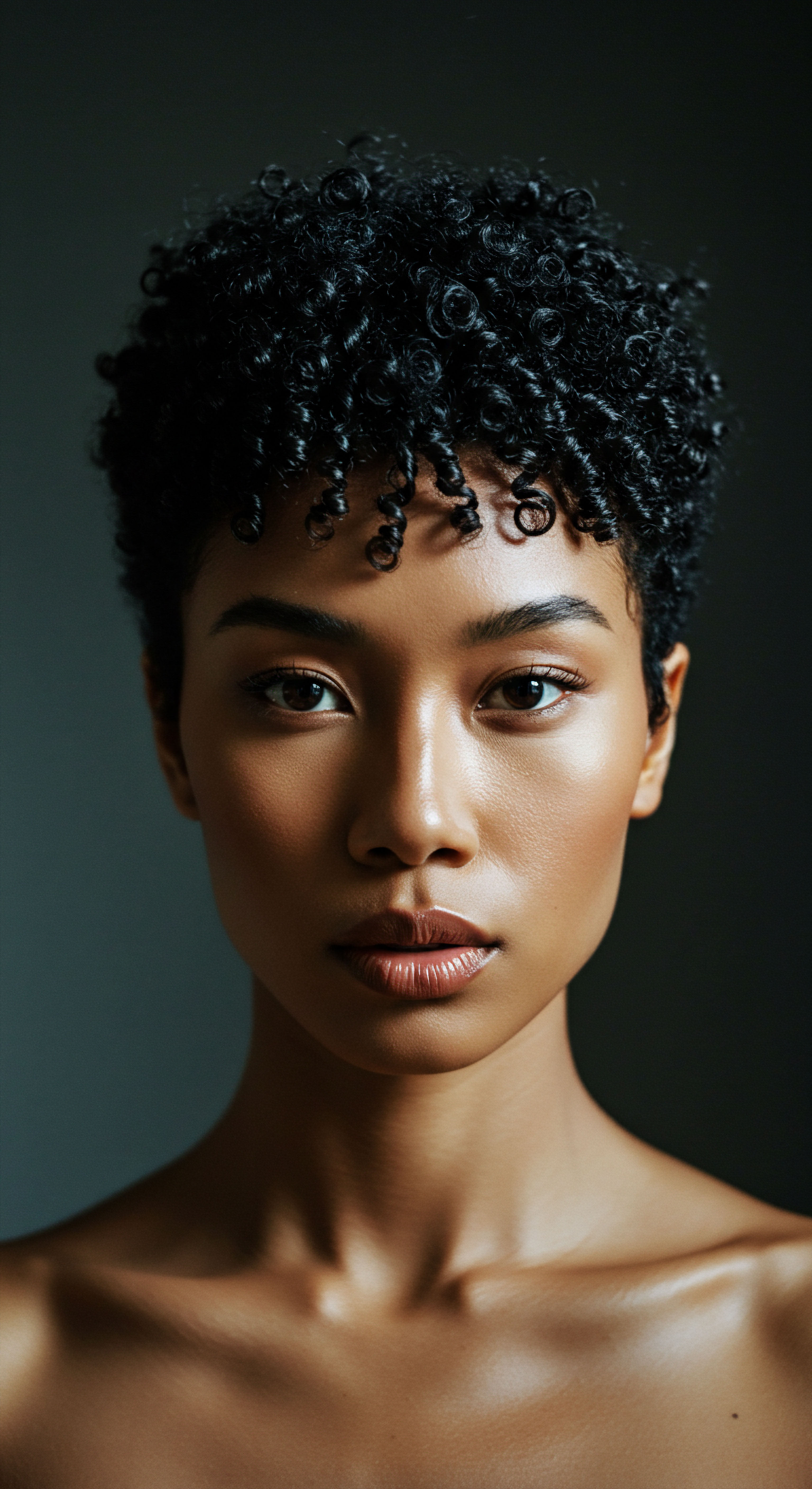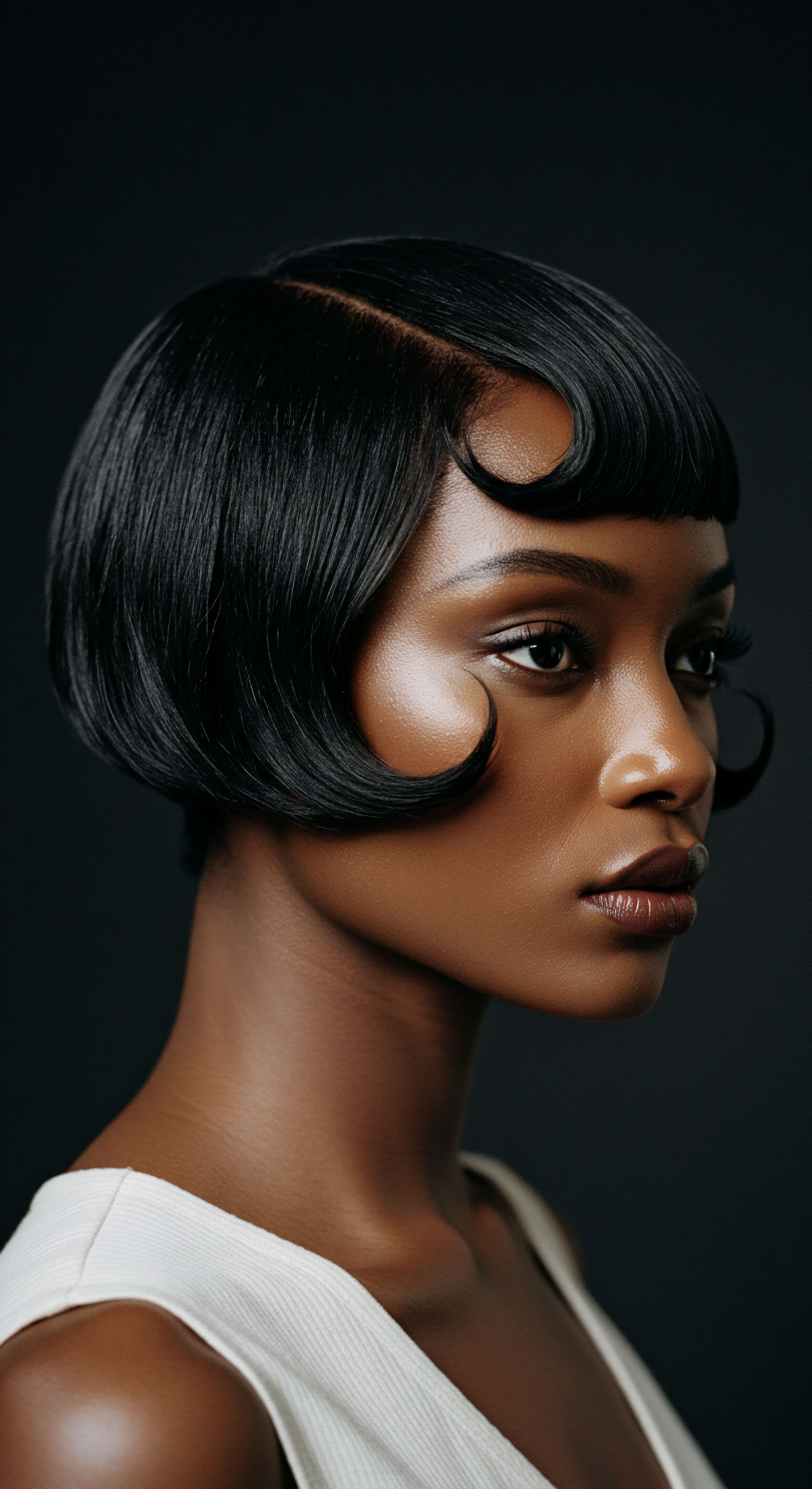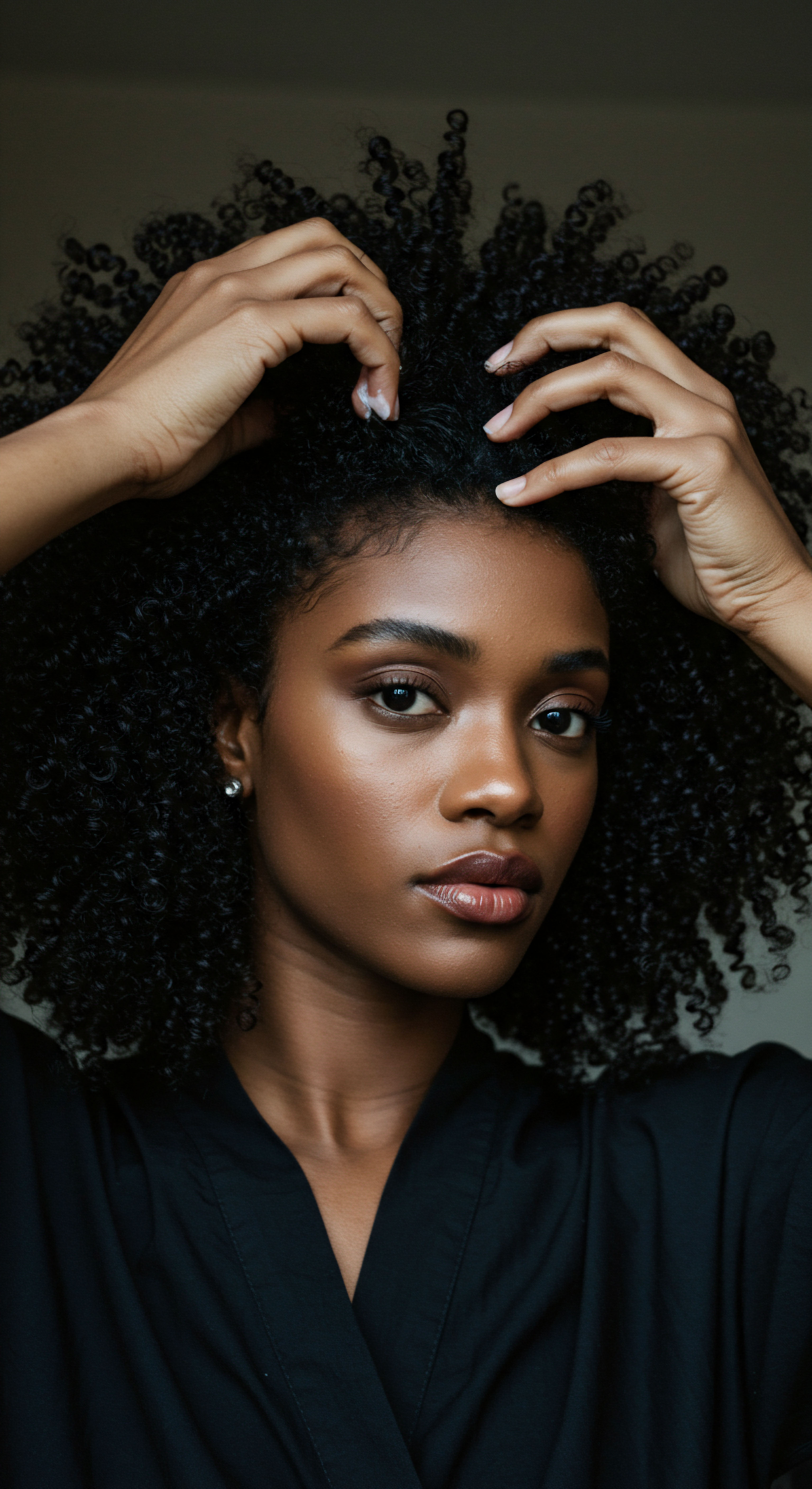
Roots
The very strands that crown us, particularly those with a textured grace, hold stories whispered through generations. Each coil, each curve, is a testament to heritage, resilience, and an innate beauty. As we consider the desire to adorn these strands with color, a natural question arises ❉ does the gentle touch of plant-based dyes truly leave our curl patterns untouched? This inquiry leads us to the fundamental science of hair itself, an elemental understanding that begins at the microscopic level.

Hair Anatomy and Its Textured Expressions
To truly comprehend how any substance, be it a vibrant botanical or a conventional formulation, interacts with our hair, we must first appreciate its intricate construction. A single hair strand, seemingly simple, is a marvel of biological engineering. At its heart lies the Cortex, a central region composed of keratin proteins. These proteins, in textured hair, are arranged in a specific way, forming the very architecture of our curls and coils.
Surrounding this core is the Cuticle, an outer layer of overlapping, scale-like cells. Think of these as tiny shingles on a roof; their condition, whether lying flat and smooth or raised and open, dictates much about how hair behaves, particularly concerning moisture and external agents.
For textured hair, the cuticle naturally possesses a more lifted structure compared to straight hair, which allows for greater water absorption but also faster moisture loss. This inherent characteristic plays a significant role in how pigments settle and adhere. The shape of the hair follicle itself, rather than the hair shaft, is what determines the curl pattern, influencing how the keratin within the cortex aligns and the cuticle layers are arranged.

Plant Based Pigments and Hair Interaction
Plant-based hair colors, unlike their synthetic counterparts, generally do not penetrate the hair’s inner cortex by breaking down its structural bonds. Instead, they operate primarily by coating the hair shaft, adhering to the cuticle layers and sometimes, the outermost regions of the cortex. This difference in mechanism is central to understanding their impact on curl.
The primary colorant in henna, for example, is Lawsone (2-hydroxy-1,4-naphthoquinone). This molecule reacts with the amino groups present in hair keratin, forming a bond that deposits color. Other plant-based dyes, such as indigo, also work by direct deposition or through complex formation with hair fibers. This gentle adherence, without the use of harsh oxidizing agents like hydrogen peroxide or ammonia that forcefully open the cuticle and alter internal bonds, is often touted as a key benefit for hair health.
Understanding hair’s delicate architecture, particularly the cuticle and cortex, is paramount to grasping how plant-based colors interact with curl.

Does Hair Porosity Matter?
Hair porosity, a measure of how readily your hair absorbs and retains moisture, profoundly influences how plant-based dyes perform. Hair with Low Porosity has tightly packed cuticles, making it resistant to moisture entry. Conversely, High Porosity hair possesses lifted or damaged cuticles, allowing moisture to enter quickly but also to escape with ease. Textured hair often exhibits varying porosities along the length of the strand, with ends potentially more porous due to environmental exposure or styling.
For low porosity hair, plant-based pigments may find it challenging to settle onto the tightly closed cuticle, potentially leading to less vibrant color or uneven results. In such cases, preparing the hair by gently opening the cuticle, perhaps with a mildly alkaline shampoo or steam, can aid in pigment absorption. High porosity hair, with its more open cuticle, can absorb the pigments readily, but may also release them faster, leading to quicker fading. This interplay between hair’s natural absorbency and the dye’s deposition mechanism is a silent partner in the coloring process.

Ritual
The act of coloring hair, especially with plant-based preparations, extends beyond a mere chemical process; it becomes a ritual, a mindful engagement with our strands. This journey into botanical hues calls for a practical wisdom, an understanding of how these ancient practices intertwine with modern hair care. As we delve into the application and aftercare, the question of curl alteration reappears, inviting us to observe with a gentle, discerning eye.

Application Practices and Curl Integrity
The manner in which plant-based colorants are applied can significantly influence their perceived impact on curl patterns. Unlike conventional dyes that often involve a rapid, chemically induced process, plant dyes typically require a longer application time, allowing the pigments to settle onto the hair shaft.
- Pure Henna Application ❉ When applying Pure Henna, the paste is often left on the hair for several hours. This prolonged contact, particularly with thicker applications, can temporarily weigh down strands. The lawsone molecules, as they coat the hair, can create a slight sheath, potentially causing curls to appear elongated or less defined immediately after the process. This is generally a temporary effect, often lessening with subsequent washes.
- Indigo and Blends ❉ Indigo, frequently used with henna to achieve darker shades, is a quick-release dye. It is typically mixed with water and applied immediately. When used in a two-step process (henna first, then indigo), the impact on curl pattern is primarily attributed to the henna component.
- Moisture Balance During Application ❉ Maintaining proper moisture balance during the application of plant-based dyes is paramount. Allowing the paste to dry out on the hair can contribute to a stiff, brittle feeling, which might temporarily affect curl flexibility. Wrapping the hair to maintain moisture and warmth during the processing time is a common practice to aid pigment uptake and preserve hair suppleness.

Do Different Plant Colorants Behave Differently?
While henna is most commonly associated with potential curl relaxation, other plant-based colorants tend to have less reported impact on curl patterns.
Chamomile, often used for lighter tones, and walnut hulls, for darker shades, primarily deposit color on the hair’s surface without the same binding properties as lawsone in henna. Therefore, their influence on curl definition is minimal to nonexistent. The key lies in the specific plant compound and its interaction mechanism with hair keratin. Henna’s lawsone molecule forms a strong adherence to the hair’s protein, creating a coating that can add weight and slightly alter the curl’s spring.
| Plant Colorant Henna (Lawsonia inermis) |
| Primary Pigment Lawsone |
| Reported Curl Impact Temporary elongation, slight loosening, increased clumping |
| Plant Colorant Indigo (Indigofera tinctoria) |
| Primary Pigment Indigotin |
| Reported Curl Impact Generally minimal to no direct impact on curl pattern |
| Plant Colorant Cassia Obovata |
| Primary Pigment Chrysophanic acid |
| Reported Curl Impact Minimal to no curl impact, conditioning benefits |
| Plant Colorant Amla (Emblica officinalis) |
| Primary Pigment Tannins, Vitamin C |
| Reported Curl Impact Can help prevent curl loosening when mixed with henna |
| Plant Colorant This table provides a general overview; individual results may vary based on hair type and product formulation. |

What Role Does Aftercare Play?
The ritual of caring for hair after a plant-based color application is just as vital as the coloring process itself. Plant dyes, particularly henna, can sometimes impart a feeling of dryness to the hair. This is not a chemical alteration of the curl structure but rather a temporary sensation that can affect how curls clump and feel.
Proper hydration and conditioning are essential to restore suppleness and ensure curls maintain their definition. Using deep conditioning treatments, applying nourishing oils, and focusing on moisture retention can help mitigate any temporary dryness and encourage curls to spring back to their natural form. For individuals with textured hair, a consistent moisture-rich regimen is already a cornerstone of hair health, and this becomes even more significant after using plant-based colorants.
Mindful application and diligent aftercare are essential components in preserving the natural curl definition when using plant-based hair colors.

Relay
Moving beyond the immediate observations of curl alteration, we find ourselves at a deeper confluence where scientific inquiry meets cultural wisdom. The question of whether plant-based hair color genuinely alters curl patterns necessitates a more nuanced exploration, delving into the very chemistry of hair and the long-term interplay of botanical compounds. This is where the subtle shifts, the whispered stories of strands, gain scientific grounding.

Do Plant Dyes Change Hair’s Chemical Bonds?
The core of a hair strand’s curl pattern lies in its Disulfide Bonds, strong chemical linkages within the keratin proteins of the cortex. Conventional permanent hair dyes and chemical relaxers operate by intentionally breaking and then reforming these disulfide bonds to alter the hair’s structure. This is why they can permanently straighten or significantly change curl.
In contrast, pure plant-based dyes like henna and indigo do not possess the chemical agents (such as ammonia or hydrogen peroxide) that are capable of breaking these robust disulfide bonds. Their primary mechanism is a physical coating and adsorption onto the hair shaft, rather than a deep chemical transformation of the internal structure. The lawsone molecule in henna, for instance, binds to the keratin through hydrogen and ionic bonds, and possibly some covalent bonds with amino groups, but these interactions are distinct from the breaking of disulfide bonds.
The perceived loosening of curls, particularly with repeated henna applications, is generally attributed to a buildup of the dye molecules on the hair shaft, adding weight and creating a thicker coating. This added mass can stretch the curl, making it appear less coiled or more relaxed. It is a mechanical effect, rather than a chemical one, and is often temporary, lessening as the coating naturally wears down or with specific clarifying treatments. For individuals with finer textured hair or looser waves, this effect might be more noticeable and persistent.

Are All Natural Dyes Truly Harmless to Curl?
While pure plant powders like henna and indigo are generally considered gentler, a discerning eye is still needed when choosing products labeled “natural” or “herbal.” Some commercial “natural” or “herbal” hair dyes may contain hidden ingredients, including metallic salts or low levels of paraphenylenediamine (PPD), which can react with hair proteins and potentially cause damage or unexpected interactions with subsequent chemical treatments.
Metallic salts, for instance, react with the sulfur in hair keratin, creating a permanent color change that can lead to brittleness, dullness, and adverse reactions with other chemicals, including perms or lighteners. If a “natural” dye contains such compounds, it could indeed impact the hair’s structural integrity and, by extension, its curl pattern, in a more permanent and undesirable way than pure botanicals. Always scrutinize ingredient lists and perform strand tests, especially if the product promises a very dramatic or long-lasting color change without the typical botanical application process.
A 2020 study published in ACS Biomaterials Science & Engineering by Zhang et al. explored a novel approach to permanent hair dyeing using metal-polyphenol networks (MPNs). This research, while not directly on traditional plant-based dyes, offers a compelling insight into how certain compounds interact with hair’s core structure. The study demonstrated that by reducing disulfide bonds in hair using thioglycolic acid (TGA), a significant number of free thiol groups were created.
These thiol groups then reacted with Fe2+ to form Fe–S bonds, facilitating the deposition of MPNs throughout the hair fibers. Crucially, the researchers observed that while the initial reduction of disulfide bonds caused mechanical and structural damage, the subsequent connection of thiol groups to the MPNs through Fe–S bonds restored the hair’s physicochemical properties almost to its original states. This suggests that while breaking disulfide bonds is inherently damaging, the right subsequent chemical interactions can mitigate this damage. This finding, though in a laboratory setting and with a specific chemical process, highlights the complex and often surprising ways substances can interact with hair’s fundamental structure, offering a counter-intuitive perspective that not all interventions affecting chemical bonds necessarily result in irreversible negative outcomes for hair integrity, particularly if a restorative mechanism is simultaneously at play.
Pure plant dyes like henna and indigo do not break hair’s disulfide bonds, the foundation of curl, but can temporarily alter curl appearance through coating and weight.

Cultural Perspectives on Hair and Color
Across diverse cultures, the practice of adorning hair with plant-based dyes has roots stretching back millennia. Ancient Egyptians, for instance, used henna to camouflage gray hair and for decorative purposes, alongside indigo and turmeric. In India and Persia, henna was mixed with indigo to achieve deep, rich tones for both hair and beards. These traditions were not merely about superficial color; they were deeply interwoven with identity, spirituality, and community.
For many with textured hair, the choice of plant-based color today is often a continuation of this heritage, a conscious decision to connect with natural elements and gentle practices. The conversation around curl alteration in this context takes on an added layer of meaning. It becomes a dialogue about preserving the inherent qualities of hair while still celebrating personal expression. The focus shifts from a fear of damage to a pursuit of harmonious enhancement, where the integrity of the natural curl is honored as a vital aspect of one’s identity.

Reflection
As we step back from the intricate details of molecular interactions and historical practices, a broader understanding of plant-based hair color and its relationship with textured curl begins to settle. The strands that frame our faces, carrying the whispers of our ancestors and the stories of our present, are indeed sensitive to the world around them. While pure botanical dyes, when used with wisdom and care, generally do not chemically alter the fundamental architecture of a curl, their physical presence can certainly coax it into new expressions. This gentle influence, often a temporary elongation or a deepening of definition, speaks to the dynamic nature of hair itself.
It is a reminder that beauty rituals, whether ancient or modern, are not about imposing a rigid form, but rather about working in concert with the hair’s innate rhythm, honoring its structure while allowing for playful, colorful adornment. The journey with plant-based color becomes less about a definitive “yes” or “no” to curl alteration, and more about a thoughtful dialogue between intention and outcome, always guided by a deep respect for the living, breathing canvas that is our hair.

References
- Zhang, H. Xu, J. Guo, J. Song, Y. Liu, X. Zhang, X. & Ding, Y. (2020). Thiol-Enhanced Interfacial and Internal Deposition of Metal–Polyphenol Networks for Permanent Hair Dyeing. ACS Biomaterials Science & Engineering, 6(11), 6062-6070.
- Draelos, Z. K. (2001). Hair cosmetics. In Handbook of Cosmetic Science and Technology (pp. 675-690). Marcel Dekker.
- Guerra-Tapia, A. & Gonzalez-Guerra, A. (2014). Hair dyes. In Cosmetic Dermatology ❉ Products and Procedures (pp. 165-174). John Wiley & Sons.
- Wolfram, L. J. (2001). Hair colouring, permanent styling and hair structure. Handbook of Cosmetic Science and Technology .
- Sukumaran, A. (2021). Is Henna Hair Dye a Bad Idea? Here’s What the Experts Have to Say. Healthline .
- Nascimento, M. R. Padoin, A. V. & Silva, C. D. B. (2023). Mechanisms of impairment in hair and scalp induced by hair dyeing and perming and potential interventions. Frontiers in Pharmacology, 14, 1163456.
- Radico USA. (2023). Why Natural Hair Colors Fade Fast – Here’s How to Make It Stick.
- Radico USA. (2025). Step-by-Step Guide for Dyeing Low Porosity Hair with Organic Hair Color.
- The Trichological Society. (n.d.). Colouring – Decolouring the Hair.
- Khadi USA Inc. (n.d.). Chemical vs. natural hair color – Making the switch easy.
- I Love Riccio. (n.d.). Henna curly hair ❉ advantages and disadvantages.
- Byrdie. (2024). The Extraordinary History of Hair Color.
- Reddit. (2025). On curly hair? It’s true Indigo Black hair dye. ❉ r/henna.
- Reddit. (2024). How often to use henna on lengths of hair? – Reddit.
- Reddit. (2023). How does henna affect hair texture and volume? – Reddit.